Bamidbar 2017 – The Wall: Continued + Sefira and Menstruation
by devadmin | May 25, 2017 8:32 pm
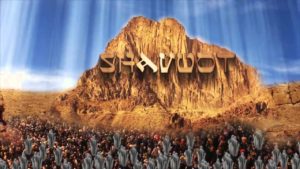 We begin this week with a special mazel tov to Zachary Grossman, upon his graduation yesterday from the Benjamin Cardozo School of Law. Zachary is of course the amazing son of the Oisvorfer and his eishes chayil Lisa.
We begin this week with a special mazel tov to Zachary Grossman, upon his graduation yesterday from the Benjamin Cardozo School of Law. Zachary is of course the amazing son of the Oisvorfer and his eishes chayil Lisa.
As Shlomo Hamelech says: toivim hashnayim min hoechod (two are better than one). A double mazel tov then to cousins Suzanne and Barry Rozenberg on the birth of twins -one of each- born to their children Alyse and Josh Rozenberg. Welcome to the world Devorah Baila (Deborah Belle) and to Akiva Netanel (Kevin Nathaniel). Mazel tov as well to grandparents Neumarks, mom and dad of Alyse. May the twins give their parents, grandparents on all sides and especially great bubby Ruth Sirota many years of nachas and joy.
Raboyseyee and Ladies:
The Wall: Continued + Sefira and Menstruation
Shoin, just by opening with a few lines on President Trump this past week, clicks to the Oisvorfer’s site were up by thousands; givaldig and let’s try it again.
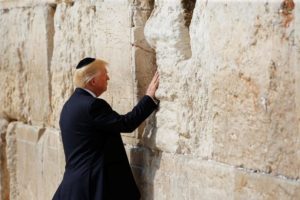 Earlier this week, both the President and his very capable daughter Ivanka were filmed while visiting Yirusholayim. The site: the Koisel Ha’ma’rovi, the Western Wall, the holiest site for Yiddin in our times. The President left a kvitel (note) in the Wall, efsher meant for the Russians ver veyst, while Ivanka, Jewish and modern orthodox, was seen davening and even shedding a very sincere tear. Nice. The Wall has that effect on many. Interestingly, security cleared out the area; not one schnorrer was to be found shaking him or her down for a donation. Ober this got the Oisvorfer thinking. Had the President been able to witness just how successful the Wall schnorrers (those with the Wall franchise) are and how they shake down thousands who come there daily, weekly and yearly, he likely would have been inspired. Might he then be able to raise significant funding for ‘his wall’ by utilizing the talents and tenacity the scnorrers display? Efsher he should consider selling dedications and bricks? Many a wall and many a structure have been built utilizing this time tested method.
Earlier this week, both the President and his very capable daughter Ivanka were filmed while visiting Yirusholayim. The site: the Koisel Ha’ma’rovi, the Western Wall, the holiest site for Yiddin in our times. The President left a kvitel (note) in the Wall, efsher meant for the Russians ver veyst, while Ivanka, Jewish and modern orthodox, was seen davening and even shedding a very sincere tear. Nice. The Wall has that effect on many. Interestingly, security cleared out the area; not one schnorrer was to be found shaking him or her down for a donation. Ober this got the Oisvorfer thinking. Had the President been able to witness just how successful the Wall schnorrers (those with the Wall franchise) are and how they shake down thousands who come there daily, weekly and yearly, he likely would have been inspired. Might he then be able to raise significant funding for ‘his wall’ by utilizing the talents and tenacity the scnorrers display? Efsher he should consider selling dedications and bricks? Many a wall and many a structure have been built utilizing this time tested method.
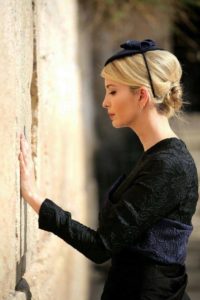 Shoin, as the Yimay Hasifra are drawing to a close (last night a few still counted 44 days in the Oimer), the heylige Oisvorfer, in a tradition which began way back when, but started by whom he does not know, is just about ready to complete his studies of the heylige Gemora Soitah (Tractate of Soitah). And why has he been studying Soitah when the rest of the orthodox world who learn Daf Yomi (lit: daily, a leaf, whose two pages are subtitled amud alef and amud beis, together known as a blatt or a page) are busily learning Miseches Bava Basra? Nu, only a real oisvorf would ask such questions because avada you know, or should (from where, ver veyst), that it’s avada a minhag yisroel (customary) for Yiddin to be studying Tractate Soitah during the days of the Sefira. It is? Says who? And why?
Shoin, as the Yimay Hasifra are drawing to a close (last night a few still counted 44 days in the Oimer), the heylige Oisvorfer, in a tradition which began way back when, but started by whom he does not know, is just about ready to complete his studies of the heylige Gemora Soitah (Tractate of Soitah). And why has he been studying Soitah when the rest of the orthodox world who learn Daf Yomi (lit: daily, a leaf, whose two pages are subtitled amud alef and amud beis, together known as a blatt or a page) are busily learning Miseches Bava Basra? Nu, only a real oisvorf would ask such questions because avada you know, or should (from where, ver veyst), that it’s avada a minhag yisroel (customary) for Yiddin to be studying Tractate Soitah during the days of the Sefira. It is? Says who? And why?
What is the connection between the Soita, the woman suspected (by her husband, say it’s not so) of adulterous behavior and who is tested in an unnatural way by having to imbibe ‘soitah water’ – a special drink blend- which quickly and miraculously determines her fate, to the Yimay Hasfira (sefira count)? Has the Oisvorfer gone mishuga? What has potential adultery to do with the Yimay Hasfira which are, in our times, dedicated to Rebbe Akiva’s students for whom we (used to) mourn? How did potential adultery get mixed up with sefira? Ober raboyseyee, be aware that this is mamish a real minhag yisroel. Ober why, and how do we connect these two disparate subjects? It’s poshit: there are 49 days in the sefira and there are punkt (specifically) 49 daffin (double sided pages) in Tractate Soitah: Shoin, 49 = 49 and a minhag was born. Is there more to this custom? Let’s find out.
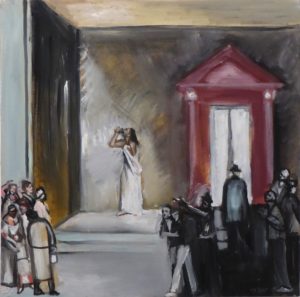 Nu, thankfully most of the Oisvorfer’s readers don’t learn too much Gemora, ober were you to open the Gemora Soitah you will taka find that its last blatt (page) is taka number 49. Ober, were you on top of your game, as you mistama are with other games you play, if you chap, you might also find that the Gemora Soitah (and all others) only begins with page 2. There is no page 1. Meaning that the Gemora Soitah does not have 49 blatt, but only 48, and if that’s the case, just how did those who connected these two numbers match up 48 in Soitah to 49 in sefira? And if that’s the case, and taka it is, why taka do we learn Soitah and its 48 blatt during the Sefira days? Nu, that’s taka an excellent question. Ober, avada there’s an answer, efsher a few, and they go like this.
Nu, thankfully most of the Oisvorfer’s readers don’t learn too much Gemora, ober were you to open the Gemora Soitah you will taka find that its last blatt (page) is taka number 49. Ober, were you on top of your game, as you mistama are with other games you play, if you chap, you might also find that the Gemora Soitah (and all others) only begins with page 2. There is no page 1. Meaning that the Gemora Soitah does not have 49 blatt, but only 48, and if that’s the case, just how did those who connected these two numbers match up 48 in Soitah to 49 in sefira? And if that’s the case, and taka it is, why taka do we learn Soitah and its 48 blatt during the Sefira days? Nu, that’s taka an excellent question. Ober, avada there’s an answer, efsher a few, and they go like this.
Some say that having but 48 blatt does not disqualify the Gemora and why we learn it during sefira days. Why not? Because many will, before beginning to learn the Gemora which taka begins on page 2, spend one day in advance getting ready to learn the Gemora. Shoin: that day counts as well. And now it all makes perfect sense. The one day of preparation, of pulling it off the shelf and dusting it off, plus the 48 pages come to 49, as do the days of the sefira count. Veyter.
So happens that it’s in next week’s parsha of Nosi where we get to meet the soitah, her jealous husband and the procedure she is put through to determine guilt or innocence, ober chap nisht. Potential chapping is why she is called soitah. It also so happens that in certain years we get to read parshas Nosi just before Shovuis while in others -this year- it’s read just after. Ober this week, we begin Sefer Bamidbar with parshas Bamidbar and let’s not spend too much time on the soitah. Let’s just mention one aspect that is relevant to our discussion. When a woman is suspected of adultery and just after drinking the Soitah Mix, then, as part of the process, a korban (which her husband brought to the koihen on her behalf) is brought to the RBSO. The main ingredient of this korban is barley and is very much similar to the Oimer offering which was also comprised of barley. The oimer offering is avada related to the yimay hasfira. Shoin: barley and barley and a minhag to study Tractate Soitah was born! Any more? Of course!
Says the Zoihar (vol 3, 97a), and who knew more about the Soitah then did he, azoy: the barley offering of the Soitah was brought by the husband and offered to restore love between the husband and his wife. Good luck with that after such accusations and suspicions. Exactly how an oimer offering made of barley which was used as animal feed helped him restore or perhaps assist in increasing his love, ver veyst. A husband who falsely accuses his wife of infidelity should perhaps consider some jewelry. Ober, as you know, the Oisvorfer has a tradition not to argue with the Zoihar. Nothing good can come from it. The Zoihar continues and says azoy: similarly, the Oimer offering and the counting of the sefiras ho’oimer are meant to bring out and strengthen the love between the metaphorical husband, in this case, the RBSO, and his wife, the Yiddin. Taka a nice pshat as we get ready to mark the anniversary of the RBSO’s marriage to the Yiddin this coming Wednesday and Thursday on the great and easy to observe Yom tov of Shovuis.
The sium (coalition), a tradition when completing a tractate will be combined with the anniversary cake as we celebrate over cheesecake and pizza. How cheesecake became associated with Shovuis is for another day.
 And before we close out this topic and look into one more of interest, listen to this thought, also from the Zoihar who says azoy: we are instructed during the sefira days to count seven weeks. So says the heylige Toirah. These seven weeks correspond to the idea of the seven clean days a woman must count (“she shall count seven days”) to be pure to her husband. What? How did the Zoihar connect sefira to a menstrual cycle? And why? Says he: Matan Toirah, which we mark on Shovuis is taka, as mentioned just above, the idea of marriage between the Yiddin and the RBSO. Before the Yiddin could marry the RBSO, they needed to be cleansed of the various impurities that were now attached to them as a result of their chapping of Mitzri women and who knows what else, while enslaved for 210 years. Therefore they were instructed to count seven weeks during which, on each day, they became just a bit spiritually cleaner. And these seven weeks are mamish like the seven clean days a bride must count before being with here bridegroom.
And before we close out this topic and look into one more of interest, listen to this thought, also from the Zoihar who says azoy: we are instructed during the sefira days to count seven weeks. So says the heylige Toirah. These seven weeks correspond to the idea of the seven clean days a woman must count (“she shall count seven days”) to be pure to her husband. What? How did the Zoihar connect sefira to a menstrual cycle? And why? Says he: Matan Toirah, which we mark on Shovuis is taka, as mentioned just above, the idea of marriage between the Yiddin and the RBSO. Before the Yiddin could marry the RBSO, they needed to be cleansed of the various impurities that were now attached to them as a result of their chapping of Mitzri women and who knows what else, while enslaved for 210 years. Therefore they were instructed to count seven weeks during which, on each day, they became just a bit spiritually cleaner. And these seven weeks are mamish like the seven clean days a bride must count before being with here bridegroom.
Shoin, let’s tie it all together. Sefira days are considered the preparation time before the wedding, the actual wedding having taken place on Shovuis. And that is why we learn Tractate Soitah during these days. They indicate the absence of union between man and his wife. How so? A soitah may not have relations with her husband (or anyone else) once she has come under suspicion until she is cleared of the charges.
Shoin, let’s pause for a moment and this coming shabbis, in addition to wishing each other good shabbis, let’s not forget to also say good Yom Tov. Why? Keep on reading. This week, the heylige Oisvorfer will give only a shtikel parsha roundup, instead he will teach his fellow Oisvorf talmidim all about a new, yet very old special day in our calendar. Aren’t we epes jumping the gun by wishing each other a gittin Yom Tov six days early? Doesn’t the special Yom Tov of Shovuois, the holiday we celebrate because the Yiddin received the heylige Toirah, begin only next week? Has the Oisvorfer gone mad? Nu, both are taka emes ober listen to this. This shabbis is taka also a shtikel Yom Tov, ober, mistama, not one they taught you much about in yeshiva. Welcome to Yom HaMiyouchas (literally – the day of lineage or Pedigree Day). And what does it taka mean? Ver veyst ober we know that the word miyuchas means a proper pedigree and pshat is that a person who has good yichus is a person who has descended from proper and important lineage. Soon we’ll close this subject with a givaldig thought; stay tuned.
 Never heard of it? Guess what. Not many did and even those who epes remember hearing epes something about it, cannot recall what it is they heard much less anything about this day, clueless mamish. In fact, just last week, the Oisvorfer asked three people, all of them at least somewhat knowledgeable, what this day was: Not a one knew. Exactly why this day is not celebrated, ver veyst ober leave it to the Oisvorfer to dig up its origins. The bigger surprise might be why Toirah entrepreneurs haven’t yet found ways to commercially exploit this holiday; that day cannot be far off. Nu, lommer lernin and zug shoin, vus iz-iz (what is it)?
Never heard of it? Guess what. Not many did and even those who epes remember hearing epes something about it, cannot recall what it is they heard much less anything about this day, clueless mamish. In fact, just last week, the Oisvorfer asked three people, all of them at least somewhat knowledgeable, what this day was: Not a one knew. Exactly why this day is not celebrated, ver veyst ober leave it to the Oisvorfer to dig up its origins. The bigger surprise might be why Toirah entrepreneurs haven’t yet found ways to commercially exploit this holiday; that day cannot be far off. Nu, lommer lernin and zug shoin, vus iz-iz (what is it)?
Ershtens, it’s a real holiday! And here are the facts. It all started on the 2nd day of Sivan in the year 2449 – mamish – but a few days before Matan Toirah. Seemingly what really took place chronologically went down like this. On the First of Sivan, the RBSO instructed Moishe to tell the nation, “You shall be a Kingdom of Priests and a Holy Nation” (Shemois 19:6). The RBSO informed us that we Yiddin were selected to be His chosen people. On the Second Day of Sivan, Moishe delivered this message and the soon-to-be Yiddin answered azoy: “Everything that the RBSO has commanded we will do” (Shemois 19:8). So that great Day of Acceptance of the Toirah by the People, though there was no Toirah quite yet, was given the title “Yom HaMiyuchas or Day of Distinction.” That’s it: a gittin Yom Tov!
Want more color? Lommer lerninin inaveynig, es ken nisht shattin (let’s review some text, it won’t kill you). On Rosh Chodesh Sivan (Thursday night and Friday this year), the about to be Yiddin arrived at the foot of Har Sinai. The purpose of creation was about to be fulfilled with the great monumental and seminal event; the Yiddin were about to receive and accept the heylige Toirah. On the second day of Sivan they were informed that their acceptance of the Toirah would elevate them to become the ‘Chosen Nation’. Says the heylige Toirah: (Shemos 19:1-8) azoy: “In the third month from the Exodus of Klal Yisroel from Egypt, on this day, they arrived at the Wilderness of Sinai. They journeyed from Rephidim and arrived at the Wilderness of Sinai and encamped in the Wilderness; and Yisroel encamped there, opposite the mountain. Moishe ascended to Hashem, and Hashem called to him from the mountain, saying, “So you shall say to the House of Yaakov and relate to the Children of Yisroel. You have seen what I did to Mitzrayim, and that I have borne you on the wings of eagles and brought you to me. And now, if you hearken well to Me and observe My covenant, you shall be to Me the most beloved treasures of all peoples, for the entire world is Mine. And you shall be to me a kingdom of ministers and a holy nation. These are the words that you shall speak to the Children of Yisrael.” Moishe came and summoned the elders of the people and put before them all these words that Hashem commanded him. The entire people responded together and said, we’re in! Veyter!
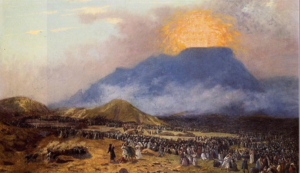 Yom HaMeyuchas coincides always with the forty-sixth day of the Sefiras Ho’oimer. Sadly for many of you, this means nothing because you stopped counting with a brocho by the third or fourth night and without a brocho just a few days later. Ober avada you are aware that we are rapidly approaching the great Holiday of Shovuois, a Yom Tov not generally observed by the reform Yiddin and one that doesn’t get any mention on the goyishe calendars. On most of our Hebrew calendars, this special day which is mamish also a Yom Tov gets no mention either; it’s mamish lost and forgotten. However and as mentioned above, this day is always marked on the Second Day of Sivan, which happens to be one day before the beginning of the Shloishes Yemei Hagbolo (the three days of restraint). Halt kup (pay attention) please. What are those you ask? Nu, efsher you recall that Moishe instructed the about to become Yiddin that they needed to restrain themselves from relations and intimacy (at home too) during the three days leading up to big day when the RBSO came down and gave us the heylige Toirah. More specifically, they were commanded beginning on the third of Sivan to physically and spiritually prepare themselves to receive the heylige Toirah. Efsher you’re wondering why abstinence during these three days was mamish a critical component leading up to the big event. Is intimacy with the eishes chayil epes a dirty zach? Not always enjoyable, nu, dus farshteytzich (well understood) ober impure? Perhaps yes: a few sages will teach us that sperm residing inside the vagina remains alive for a few days, ober it is considered dead on or after day three. Seemingly that is or was the case because Moishe specifically told the people that he wanted them to be pure on that special day (Matan Toirah day) and purity included abstinence. And when was that day? Nu, believe it or not, it’s epes not clear. Says Rav Yosi that this occurred on the 7th day of Sivan (only for this first Shavuois), ober says one Tannaitic opinion that it was on the 6th of Sivan. Shoin!
Yom HaMeyuchas coincides always with the forty-sixth day of the Sefiras Ho’oimer. Sadly for many of you, this means nothing because you stopped counting with a brocho by the third or fourth night and without a brocho just a few days later. Ober avada you are aware that we are rapidly approaching the great Holiday of Shovuois, a Yom Tov not generally observed by the reform Yiddin and one that doesn’t get any mention on the goyishe calendars. On most of our Hebrew calendars, this special day which is mamish also a Yom Tov gets no mention either; it’s mamish lost and forgotten. However and as mentioned above, this day is always marked on the Second Day of Sivan, which happens to be one day before the beginning of the Shloishes Yemei Hagbolo (the three days of restraint). Halt kup (pay attention) please. What are those you ask? Nu, efsher you recall that Moishe instructed the about to become Yiddin that they needed to restrain themselves from relations and intimacy (at home too) during the three days leading up to big day when the RBSO came down and gave us the heylige Toirah. More specifically, they were commanded beginning on the third of Sivan to physically and spiritually prepare themselves to receive the heylige Toirah. Efsher you’re wondering why abstinence during these three days was mamish a critical component leading up to the big event. Is intimacy with the eishes chayil epes a dirty zach? Not always enjoyable, nu, dus farshteytzich (well understood) ober impure? Perhaps yes: a few sages will teach us that sperm residing inside the vagina remains alive for a few days, ober it is considered dead on or after day three. Seemingly that is or was the case because Moishe specifically told the people that he wanted them to be pure on that special day (Matan Toirah day) and purity included abstinence. And when was that day? Nu, believe it or not, it’s epes not clear. Says Rav Yosi that this occurred on the 7th day of Sivan (only for this first Shavuois), ober says one Tannaitic opinion that it was on the 6th of Sivan. Shoin!
Ober did anything really happen on this day that we now call Yom HaMiyuchas? Seemingly not and believe it or not, all seem to agree that mamish nothing took place on this date. In other words, the 2nd of Sivan really has no merit on its own. And if that’s taka the case, why does it have a special name and what’s taka pshat here? Seemingly, Yom HaMiyuchas finds itself in between two other significant days. The day before it is Rosh Choidesh Sivan and the day after is the beginning of the three days leading up to Shovuois. Seemingly, its entire claim to fame is that it is epes sandwiched in between two special days and times and avada from time to time, most taka enjoy a good sandwich, if you chap.
 Ober if nothing happened that day, why was it taka named and why has it become a special day on the Hebrew calendar? Says the Sefer Taamei HaMinhagim, a more than excellent source for many of the things we do and customs we either observe or don’t, azoy: 1- This was the day that the RBSO told the about-to-become Chosen People (Yisro 19:6) “V’AtemTihiyu Li Mamleches Kohanim” (you will be to me a kingdom of Kohanim). So on this day, the Yiddin received their special Yichus setting us apart from the rest of the nations. 2- Alternatively, when the other nations questioned why the Yiddin received the Toirah, the RBSO told them to bring their Sefer Yuchasim (credentials), to see if their pedigree would stand up to the level of the Yiddin’s forefathers which included Avrohom, Yitzchok, and Yaakov. 3- It was a regular day that found itself between two special days and therefore, by proximity and association, it too became special.
Ober if nothing happened that day, why was it taka named and why has it become a special day on the Hebrew calendar? Says the Sefer Taamei HaMinhagim, a more than excellent source for many of the things we do and customs we either observe or don’t, azoy: 1- This was the day that the RBSO told the about-to-become Chosen People (Yisro 19:6) “V’AtemTihiyu Li Mamleches Kohanim” (you will be to me a kingdom of Kohanim). So on this day, the Yiddin received their special Yichus setting us apart from the rest of the nations. 2- Alternatively, when the other nations questioned why the Yiddin received the Toirah, the RBSO told them to bring their Sefer Yuchasim (credentials), to see if their pedigree would stand up to the level of the Yiddin’s forefathers which included Avrohom, Yitzchok, and Yaakov. 3- It was a regular day that found itself between two special days and therefore, by proximity and association, it too became special.
And the lesson here? Seemingly Yichus counts for something, sometimes even a lot, ober one’s own, and not that one’s own and not that of his mishpocho. A person is rewarded for his own achievements, not those of his father’s or his sons. A guiding principle that we were always taught in yeshiva and elsewhere is that a Talmid Chochom who is a Mamzer (illegitimate son), is more important than a Kohain Godol who is an Am HaAretz (ignoramus). And the bottom line: when it comes being counted and yichus, it’s best to make your own. Case closed!
Nu, speaking of being counted, welcome to Parshas Bamidbar which taka begins with a headcount of the Yiddin. In case you’ve been wondering but were too embarrassed to ask why Sefer Bamidbar which recounts the travails of the Yiddin during their 40 year sojourn though the midbar, is known as The Book of Numbers, a name that doesn’t epes translate from Hebrew to English properly, nu, let the Oisvorfer explain. It’s mamish so poshit. Avada you know that this book begins with a count, a census of the Yiddin and it turns out that Chazal (our Sages) referred to the fourth book of the Toirah as Sefer HaPekudim – The Book Of Counting. Gishmak and simple. Presumably this name was epes connected to the census found in this week’s Parsha, ober ver veyst for sure. There was at least one previous count back in Sefer Shemois.
Nu, if ever you wanted to take a shabbis off from listening to kriyas hatoirah, you might consider this one. Other than counting people, first all males above the age of 20 from every sheyvet (tribe) but Levi, and then a separate count for the liviyim. Not much else going on. Why the liviyim merited their own count is avada the subject of many discussions but the bottom line is that all the other shevotim participated in the making of the eygel (golden calf) but the leviyim kept their hands clean, so to speak, and as a shtikel reward, the RBSO counted us (the heylige Oisvorfer also a levi) separately and gave them a special assignment in the midbar. Other rewards include the great merit of washing the hands of the koihanim and of course, efsher the biggest of all for being such faithful Jews, was the RBSO’s declaration that Leviim don’t get to own any land in Israel. Instead they get to schnoor off the other shevotim. Nu, is this a reward or what? Who says we have to understand everything? Why bother with ownership, mortgages, taxes and repairs, isn’t free always better?
Some say that Parshas Bamidbar is otherwise also linked to Shovuois since the Parsha presents the names and leaders of each shayvet (tribe) of the Yiddin and some say that this delineation of the leaders promotes the idea that the heads of the community should be paragons or teachers of Toirah. Finally, since the Yom Tov, Shovuois is upon us, let the Oisvorfer remind those that are a shtikel or more lactose intolerant to stock up on whatever helps them get through, before and after. Avada you all know that we Yiddin have a shtikel minhag to eat milichiks (dairy) over Yom Tov though the Oisvorfer admits to not being able to find any real credible sources for this custom. Mistama this minhag came about as do many others in the frum world because a few people in the dairy business needed to make a parnoso and with the Gemora requiring that meat and wine be consumed in order to enjoy any Yom Tov meal, and with two and three day Yom Tovs cutting into their revenues, found it necessary to create an exception which avada became a minhag and which ultimately became the law. We call that guerrilla marketing but it seems to have taken hold.
One medrish suggests that the Yiddin, upon receiving the Toirah, could not eat any of their meat products since the meat that they had was not prepared in accordance with the newly given shechita (ritual animal slaughter) and other dietary laws. Once the heylige Toirah was given, the Yiddin refrained from eating meat because they now needed to learn the laws of kosher slaughter and to avada kasher their utensils in the mikveh. Where they found a mikveh in the midbar, ver veyst but as we have discussed in the past, this Midbar was a magical place and if the RBSO wanted a mikveh to suddenly appear so that the good Yiddin could toivel their equipment and their utensils, is that so hard to believe? But before the magical mikveh appeared, what to do and what to eat? Nu, they improvised and ate milichiks while studying these new kosher concepts. And so it happened that on Shovuois, the great holiday when we recall receiving the heylige Toirah, they ate cheesecake, blintzes, ice cream, pizza and other such delicacies. Emes, ver veyst? On the other hand, didn’t we learn that the Yiddin ate Munn for 40 years in the midbar? Indeed we did. Ver veyst?
On a more mystical level, the gematria (numeric value of the Hebrew letters) of the word for milk- cholov- is 40 and avada forty corresponds to the forty days and nights that Moishe spent up on the mountain learning the heylige Toirah. Shoin! And now you know.
A gittin Shabbis and a gittin Yom Tov!
The Heylige Oisvorfer Ruv
Yitz Grossman
Source URL: https://oisvorfer.com/bamidbar-2017-the-wall-continued-sefira-and-menstruation/